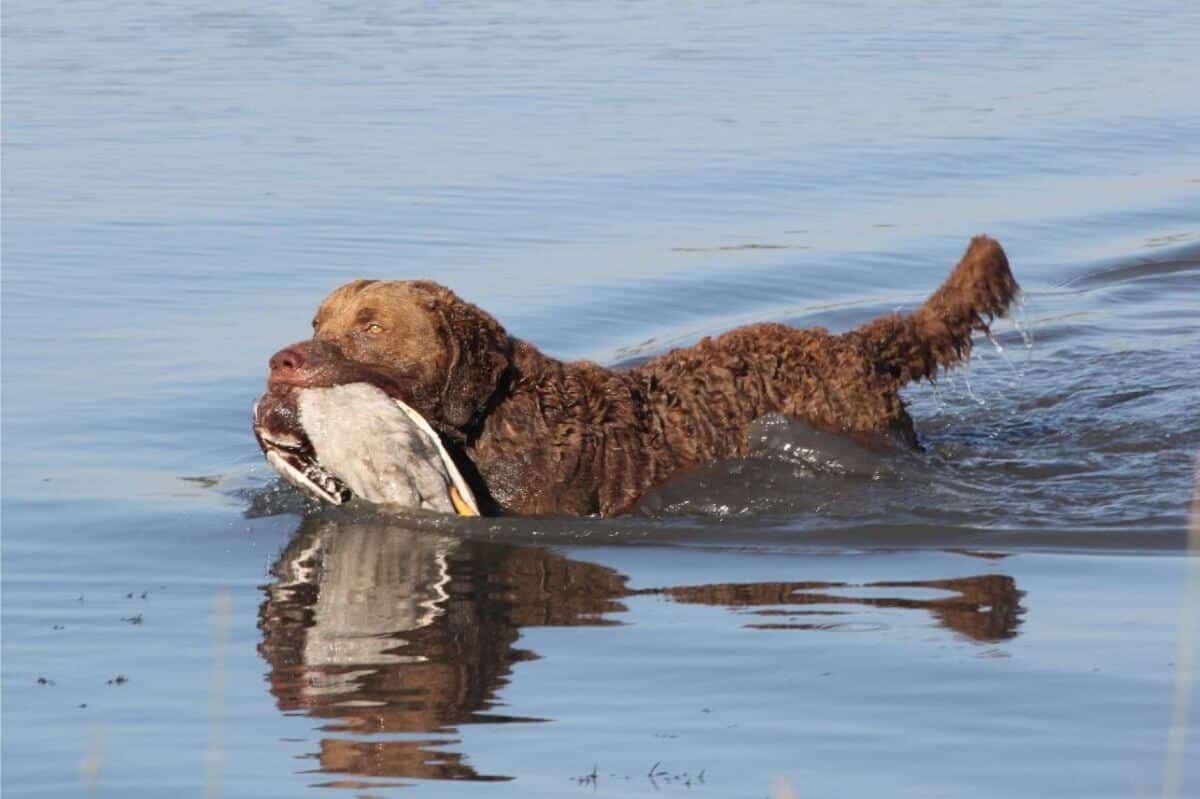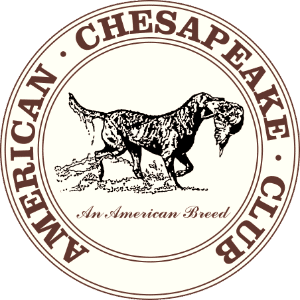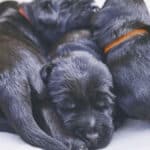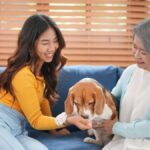Articles Provided by the American Chesapeake Club
The Chesapeake Bay Retriever in the Field
By Emelise Baughman
Maryland in the 1800s was a sportsman’s paradise, with a variety of waterfowl in the Chesapeake Bay as well as the surrounding lakes, rivers, and marshes. This required a superior dog for hunters, and became the birthplace of the premier waterfowl dog, the Chesapeake Bay Retriever. Two Newfoundland puppies rescued from a shipwreck in 1807 were bred with local dogs towards the goal of developing a strong, determined, yet gentle retriever for both local watermen and gentlemen hunters. Their success was formalized in 1878 with AKC recognition, with that success still evident today.
Although the Chessie ranks below Labs and Goldens in terms of numbers registered, many hunters would have no other dog. They retrieve ducks and geese, of course, but also upland birds like pheasant, quail, and doves. This means they have to be strong, able to navigate all bodies of water and varieties of terrain, and tolerant of both cold and heat. Chessies are intelligent, independent thinkers, but little will stop them due to their strong drive and desire to retrieve; so the hunter must be careful to not send them into risky situations, such as ice shelves in strong current or overly hot, humid upland hunts.
Many dog fanciers also prefer Chesapeakes because they are dual purpose, successful in both the field and show ring. The dense double coat offers great protection for the field dog, but needs minimal grooming; so they can easily do both in one weekend, showing one day while hunting or competing in hunt tests or field trials the next. There have been 140 Champion/Master Hunter Chesapeakes, more than twice the total of Labradors achieving both titles. They compete less often in field trials, but there have still been some great Field and Amateur Field Champions as well as 19 elite Dual Champions.
Suggestions for New Judges
By Nathaniel Horn
Judging your first Chesapeake assignment may convey surprises. You’ve attended seminars and specialties, received mentoring, and reviewed educational materials. What follows is advice to
further prepare.
- Outline: Some breeds have a square proportion and a level topline. The Chesapeake is slightly longer than tall (thus variance in the proportion). The Chesapeake rear is as high as or a trifle higher than the forequarters (thus topline variance). Topline can also vary with an approximate gentle “S” curve or, in fact, a level topline. While viewing profile, you must also consider the head, neck, size, angulation (front and rear), underline, feet, and tail as they appear within the profile. The Chesapeake is definitely not a cookie-cutter breed. As you walk down the line you may have six dogs that show good profiles with vast differences.
- Condition: The Chesapeake must have the strength and stamina to perform all day long, with proper muscle tone comparable to an athletic swimmer or marathon runner. He must be capable of performing on both land and in water. Slight weedy specimens or bulky, over-muscled specimens are not desirable. Focus on the ideal.
- Head: Head type can vary within the specifications of the standard. To avoid mistakes, understand the nuances: The expression must be intelligent with a willing-to-work attitude; the implied oval eye is medium large, yellowish or amber; broad, round skull and tapering muzzle of equal lengths, medium stop; ears small, hang loosely, with medium leather; lips thin, not pendulous. The standard provides information and measurements as guidance. For example, eyes wide apart (guideline 2½ to 2¾ inches).
- Coat: The double coat’s texture, length, density, and degree of waviness within the description are a knowledge judges need to develop. The coat color and how to judge it must be studied. Some of the more common shades of sedge, deadgrass and brown are easily recognizable. Be prepared as a judge to deal with specimens that may have a coloring that is atypical: For example, color variation, face masking, stripes, tan points, and grey color.
- Gait: The front should have full liberty of action and a well-angulated rear of great strength. Gait should be consistent with the vision of a well-toned athlete with good reach and drive from the side and deliberate soundness both coming and going.
If unsure while judging, check your standard.
Just for fun, a two-month-old puppy walking on a teeter shows excellent movement for her young age.
A four-month-old puppy showing balanced front and rear with desirable angulation, good coat, and a chest that already reaches to his elbow. He has correct length of body proportions and length of leg. Correct head proportions of muzzle to skull and lovely neck into shoulders.
Judging the Chesapeake Bay Retriever
Judging of the Chesapeake Bay Retriever begins before any hands-on examination. When the dogs first enter the ring, have them stand to be able to see the outline. The outline of the Chesapeake is different from any of the retrievers. One is looking for a dog exemplifying strength, adequate bone, slightly longer than tall. Most importantly, one is looking for a level topline or one that rises slightly to the rear—no sway or weak back. And equally, one is looking for a distinctive bottom line—chest at least to elbow, well-developed barrel rib cage, short flank and a distinctive tuck-up under the loin.
As one initially moves the dogs around the ring, evaluate the strength of the drive in the rear, the reach and, equally important, the return of the front leg under the body. Look at tail carriage—horizontal to the back. [The tail] can be held somewhat higher when excited, but not curving in a semi-circle over the back.
Approach the dog for the hands-on part of the exam, at a slight angle. Avoid [approaching] straight-on to the front and staring eye contact. Examine only the front of the teeth for bite. The standard calls for scissors or level bite. There is no mention of missing teeth and the dogs may be uncomfortable with a side exam. At this point, one may want to tilt head up slightly to check for disqualifying white which extends above the breastbone onto the neck. Major points in examining the head are: The equal length of muzzle to topskull; tight lower eye rims; moderate stop; pointed, but not sharp, muzzle; and high-set, short ears.
Continuing over the dog, one will be looking for a strong, moderate length of neck blending into the shoulder. There is no mention of a prominent forechest in the standard, but do check for good fill of the chest. Check the dog’s elbow and extend fingers to the chest to be sure depth is at least to the elbow. No gaps should be felt or seen between the elbows and the chest. Note the feet next. The standard calls for hare-shaped feet; white on toes is permitted as well as a white spot on the back of the foot.
Finally, the coat—there is no preferred waving pattern and one will see several. The main important aspect of the coat is the texture—coarse, waved outer coat and dense, wooly undercoat. The coat should not curl, meaning a full ringlet (think Irish Water Spaniel). The coat may also wave in a kinky pattern and give the appearance of a straight coat, but the individual hairs do wave.
Color can be any shade of brown, from a light blonde color (light deadgrass) to shades of red (sedge) to tans and dark browns. Solid or self-colored is preferred. There are no faults for patterns such as masking or saddling. The eyes do not have to match or blend with the coat color. A dark brown dog with a light yellow eye is within the standard.
Let’s discuss DQ’s. The DQ for lacking in breed characteristics is plural, so there is not a DQ for one characteristic. However, it is up to the judge to decide if the dog is lacking merit, so certainly withhold or excuse if that is the case. The DQ for black in the coat would only be applicable if the nose leather is black. Length of coat on tail refers to furnishings or fringes of hair. Do not unwrap the tail hair to check for length, but look at the underline of the tail for long hanging hairs. When assessing if a dog should be excused for temperament, a dog that seems timid or unwilling to stand should be excused. Don’t push to examine the dog as it could escalate the behavior.
In conclusion, one is looking for a strong, active, alert, willing dog with a good textured double coat, strength and effortless in movement especially in the rear, and balanced front and rear. Look for a dog in condition and appearing as if he/she could work all day, in any weather.
Chesapeake Bay Retrievers – Current Concerns
Size: our standard allows a variance of 3″ at the top of the withers for males 23-26″ and also for females 21-24″. You could have a smaller bitch at 21″ and a taller dog at 26″ in your ring with a difference of 5″. In some parts of the country, you will see taller dogs. In other areas, the average males being shown are 24½”. If a dog is taller than the majority of the entry, he is not wrong. There is no height preference within the stated heights. It is important to know the size ranges.
Feet: The Chesapeake should have hare feet. It is the only retriever breed with a hare foot which gives the dog a better grip when climbing muddy banks or encountering ice during winter hunts. You will see some rounded cat feet instead of a correct foot with two longer toes on the center of each foot with less arching. The cat foot does not cover as much ground and offers less traction when the dog is on mud, ice or uneven ground.
Short Legs: It is very strongly stated in the breed standard that “shoulder to elbow and elbow to ground should be equal.” Short legs do not permit the Chesapeake Bay Retriever to run as quickly or efficiently. There is not only a disadvantage in the field, but swimming strokes are also impacted. Legs that are equal from elbow to shoulder and from elbow to ground provide a longer stroke; fewer strokes and more endurance for the swimming dog.
Lack of Balance: As with so many breeds there are problematic straight shoulders, but even more cases of short upper arms. Many rears are correct and are well-angulated, but the dog is not balanced. To quote from the breed standard: “Shoulders should be sloping with full liberty of action…” Bad fronts are the major fault in our breed. In addition, unknowledgeable breeders are also producing “balanced dogs” that lack an adequate amount of angulation, both front and rear. While sound, unfortunately, they have restricted movement on ground and inefficient swimming ability.
The Good News: The Chesapeake coat is the Hallmark of the breed. The breed standard says: “The double coat consists of a short, harsh, wavy outer coat and a dense, fine, wooly undercoat…” Coats have improved tremendously over the years. More Chesapeakes have better coats than in the past. Quality is better and there is more consistency with harsh, dense coats and the desired undercoat. In addition, the trend and temptation towards over grooming is not as prevalent as it used to be.
by Betsy Horn Humer, JEC
by JoAnn Colvin
Hard to Maintain Traits in the Chesapeake Bay Retriever
Chesapeakes are not an easy breed to judge because there are acceptable variations of type (style), which is very typical of a breed that is bred primarily for working traits. Chesapeake breeders are not concerned about cosmetic features such as the nose color and eye rim pigmentation as examples. The breed should and must be judged on those traits that are the most important for its function as a retriever.
Correct proportion- The breed is only slightly longer than tall with a well-coupled (short) loin. To keep this right body length proportions is a very difficult trait to maintain in breeding. The majority of CBRS that you see are generally too long in loin length with the MOST grievous fault long in body and short in leg. Long in body and short in leg with a large head and a cloddy appearance (like a working breed) is the first stage of dwarfism in the breed. Too often the just off square dog is viewed as “wrong” instead of as right. Dogs with the correct proportion are not sway backed or have an extreme rise to the rear.
Substance- It can be difficult in breeding to maintain enough bone and substance of body. The chest depth should reach at least to the elbow (ideally below). The Chesapeake is not a breed well up on leg nor short legged and dumpy. Do not mistake the fully mature animal as overdone. Just think, is the dog athletic in appearance; in good condition of muscle? Call to mind the conditions in which this breed works-mud flats, swift rivers and tidal waters-it needs muscle, power, and athletic agility.
Head Traits-The head qualities for this breed are directly related to its function. There must be sufficient length of muzzle with a “pointed, not sharp appearance” to hold game birds properly. “Ears are to be small, set well up on the head” to keep the ears out of the water. Blocky is not a term or a look that should be applied to this breed. Squared off muzzle shape is totally wrong. Ideally the width of the skull (measured around the ears) should be twice as wide as the width of the muzzle directly below eyes. Proportional to the size of the dog and its sex. It is difficult to retain enough width below the eyes though especially in females. Narrowness there is not as serious a fault as a short muzzle or too blocky below the eyes or too prominent a stop. We all love a handsome or gorgeous head on a Chesapeake but not at the expensive of what is behind the head! The coat and the physical structure of the dog are the prime elements of importance to its work.
Dyane Baldwin









